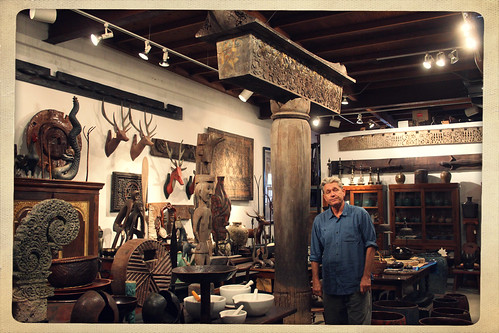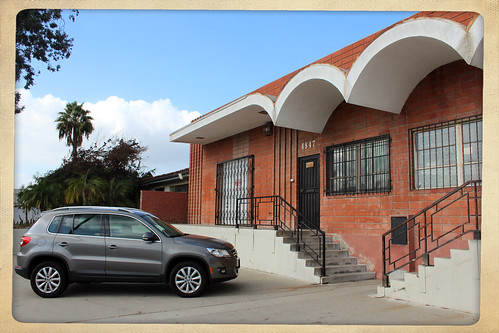PRIMARY SOURCE ARTS
JOHN STRUSINSKI AT HIS WORKSHOP IN DOWNTOWN L.A.

A modern-day Indiana Jones, John Strusinski is anything but your normal gallery owner.
Strusinski has been collecting and dealing tribal art for more than 30 years, his adventures to find ancient artifacts and antiques have taken him throughout the Americas, Europe, Southeast Asia, Oceania and Indonesia.
His story is an epic odyssey involving mafia-owned nightclubs, a bus from Italy to Afghanistan, Everest expeditions, and mystical lagoons.
(SEE VIDEO)
WATCH THE EXTENDED VIDEO ABOUT JOHN'S STORY HERE. |
“It started off with a bang,” said Strusinski.
The transition from adventurer to gallery-owner was a coincidental stroke of luck. While on a trip to Thailand he wandered into an antique store where he met Mark Richards, a man from Los Angeles who specialized in importing works for an emporium of tribal and Hindu/Buddhist art.
“It was a chance meeting that led to a great collaborations,” said Richards.
Richards hired Strusinski to work as a traveling collector for his Jefferson Blvd. warehouse that Strusinski now owns.
“While I was out traveling the Indonesian archipelago collecting artwork for Mark to sell, he let me store my own collection in a corner of this warehouse, since 1979,” said Strusinski.
After five years, Richards decided to move into the contemporary arts business in the late '80s he offered the space to Strusinski.
“It worked out perfectly," said Strusinski. "I had enough money by that time to start my own gallery. I’ve been here since 1989 and I also own a sister workshop and warehouse in Bali, Indonesia.”
Primary source arts holds an extensive and eclectic inventory, that includes masks, sculptures, jewelry, textiles, armaments, furniture and architectural elements from Southeast Asia, Indonesia, Papua New Guinea, and Africa, according to its website.
Strusinski’s gallery also serves as his workshop and studio for a project he has been working on for almost 40 years. Over this time he has managed to collect over 1,500 specimens of Indonesian keris, or sacred daggers, which have a wavy blade and a deity or guardian on top of the shaft that protects the whole ensemble.
“The Indonesian people are very protective of these because they believe that the most worthy ancestor live in the blade," said Strusinski.
The keris serve several purposes in Indonesian culture, which historically have included cutting the umbilical cords of newborn children, harvesting and protecting the house.
Strusinski has recently completed his collection and is now working with his son, Oreon, to photograph and digitalize the entire database of information.
“My dad is really amazing. He’s definitely not your average father, but he’s so passionate about what he does and I’ve really enjoyed helping him finish something he has been working towards for so long,” said Oreon.
After the database is completed, Strusinski hopes to sell the daggers as a whole collection to a museum.
“My dream is that the collection stays together, and the extensive research gone into the project proves an expert source for Ph.D. students at a museum. I won’t sell it unless it goes to a good source,” said Strusinski.
“He’s really one of the last remaining people that know anything about these objects because the modern generation doesn’t really care about them,” said Oreon.
Because the gallery operates by appointment-only, selling to museums is one of the ways that Strusinski is able to continue to make enough money to continue collecting.
These deals do not happen every day, but when they do come around every couple of years they provide enough income in one sale to keep his business open.
Primary Source Art pieces have become a part of many public and private collections including the Metropolitan Museum of Art, the Boston Museum of Fine Art, the Fowler Cultural Museum in Los Angeles, the Bowers Museum in Santa Ana, the Mingei Museum in La Jolla, the Thomas Jaffe Collection in New York City, and the Ghysels Collection in Belgium.
“I don’t want to waste my time entertaining people who don’t actually want to buy. That’s why I kept the gallery downtown and not in a ‘walk-in’ environment like Beverly Hills. 90 percent of the people who come in here spend money. And out of that percentage sometimes four months of business can be done in an hour,” said Strusinski.
It’s not a business with a steady monthly income, in fact most of his money is invested in the art that takes up almost every inch of space in his warehouse, according to Strusinski.
Although his adventure travels are now limited to his other home in Indonesian, Strusinski makes up for this by reading and serving on committees of tribal art shows as well as the Los Angeles Association of Tribal Art Dealers. Through his journey and continued academic study he has become one of the world’s experts on the art and culture of the Indonesian archipelago.

|
WATCH A PHOTO SLIDESHOW OF THE GALLERY PRIMARY SOURCE ARTS GALLERY